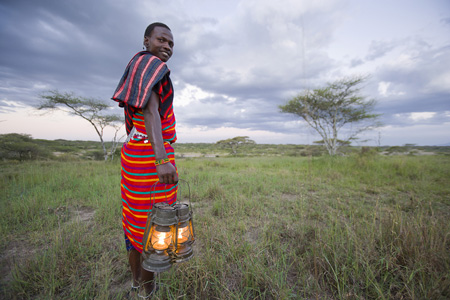
10 Apr INTO AFRICA: Part Five — Among the Maasai
MAASAI MARA NATIONAL RESERVE – Nighttime at Bateleur Tented Camp, just outside Maasai Mara National Reserve in western Kenya, near the Tanzanian border.

©Patrick Endres
I’ve just returned to my tented, bush-surrounded camp cabin after a spectacular dinner on Bateleur’s open-air dining verandah: coconut carrot soup; a salad of pumpkin, beetroot, and rocket with walnuts; grilled Indian Ocean prawns with stir-fried onions, potato, spinach and corn; and a mousse-like chocolate pate with passionfruit sauce.
Eating such sophisticated, elegantly prepared cuisine on a full setting of china, silverware and crystal, choreographed with gracious, efficient service, it’s hard to believe that a couple of hours earlier we were scrambling, scraping, banging and bouncing over the Mara Plains – but that’s one of the fundamental joys of this journey, which combines long and rigorous drives into the bush with exquisite comforts back at the camp.
Right now I’m sitting on a luxurious king-size bed surrounded by old leather traveling cases, leather-bound books on a mahogany desk, and wooden spears. Behind me is a porcelain sink with gleaming brass taps, a separate stone-floored shower area with organic shampoos and lotions and a certifiably high-powered shower, and a wood-paneled bathroom with a modern toilet. In front of me is a roof-to-floor mosquito net that I’ve zipped shut, and beyond that the deeply dark night alive with a symphony of surrounding sounds.
When I left the dining verandah to make the three-minute walk back to my cabin, a guard carrying a rifle raced to walk with me. “We must be careful, sir,” he said, arcing a powerful flashlight down the path and off into the bush. “You never know what is waiting for you. A few days ago I found a big Cape buffalo right there,” and he turned his light on the waist-high grasses not ten feet away. My heart skipped a beat. No buffalo tonight.
The day began with breakfast at the Mount Kenya Safari Club, then a short drive to Nanyuki Airport, where we boarded another propeller plane for the flight to the Maasai Mara airstrip. From there we drove over a deeply rutted road – past a broken-down gas truck that looked like it was becoming part of the landscape — to the tented camp, where we settled in, had lunch, and then met Andrew, a local Maasai teacher who would bring us to his nearby village.
As we drove to the village, Andrew told us about the Maasai diet. “Traditionally, the Maasai eat meat, milk, and blood from cattle,” he said. “We take the blood from the jugular vein. Now we sometimes also eat meat and milk from goat and sheep.” He also told us about how the Maasai use nature’s “living apothecary”: Leaves, roots and bark are all used as medicine, from twigs that are used in dental care to herbs that are used for stomach ailments to what he called the “Kenya green heart,” which is used to cure malaria.
When we reached Andrew’s village, he invited us to enter through a break in the encircling fence of thorny acacia. “Four families live in his village,” he said, ”and there is one entrance for each family. As you can see, the village consists of about a dozen huts, each made of mud laid over interlacing branches. Responsibilities in the village are clearly defined: Men do the cattle grazing, settle disputes between villages, provide security during the night, and mend the fence around the village. The women work a lot: They build houses, do cooking, fetch water, milk cows, fetch herbs and take care of the village during the day. There are more houses than families because the Maasai practice polygamy, so one man usually has multiple wives – depending on the number of cows he has; the more cows, the more wives he can marry. Each wife builds her own house.
Suddenly a line of women, resplendent in brilliant red, white, yellow and purple robes, long dangling beaded necklaces and large looping beaded neckbands, assembled in the middle of the village and began to chant. “They’re welcoming you,” Andrew said, as they smiled and sang, their voices rising into high-pitched cries.
After their song, we took pictures with them and then Andrew invited us into a typical hut. It was dark and stuffy – small triangular windows latticed with branches are the only source of light and ventilation – but as my eyes accustomed to the light, I could make out a room lined with cattle skins. “This is where the adults sleep,” Andrew said. “Here,” and he motioned toward the skins, “you can touch them.” I reached out and ran my fingers over the soft-prickly hair that covered the skin, and tried to imagine what it would feel like to sleep on that thin spread every night.
“Here is where we cook,” Andrew said, walking into the next room and pointing at a fire pit in the middle. Flies buzzed drowsily, and the scent of smoke seemed to hang in the air. “This is the children’s bedroom,” he continued, moving into the next room, which was lined with more skins for sleeping. Then he pointed into a dusky corner, “And that’s a room for the goats over there."
Though the air was hot and close and seemed to cling to my skin, something kept me in that hut. I tried to imagine waking up to the first gray light of dawn seeping through the latticed windows; walking out in the morning air to tend the cattle; cooking around the fire pit, the smoke penetrating every pore as it curled lazily toward a tiny opening in the ceiling; eating around the fire; falling asleep on the cattle skins to the breathing of the goats and the sounds of the encroaching Mara night. “Next time you visit, you can sleep here as my guest,” Andrew said, and his eyes flickered with a warm light.
We re-emerged into the blinking-bright afternoon, admired some of the wood carvings and beaded jewelry the women had arranged on selling stands, and then prepared to leave. As we walked toward the fence-exit, flies buzzed, a baby goat bleated, and a gaggle of giggling kids ran around us, smiling and waving, “Hello! Pen! Goodbye!” When we laughed and waved and said hello back, their eyes danced with delight.
Hello! Goodbye! Smiling and waving as we walked through the fence, we shook hands with Andrew and offered effusive thanks, then clambered into the van, full with the sense that we had been given two gifts: the first a brief but intense immersion into a very different world; the second a slivery but lasting connection that somehow transcended those differences.
Now, the deep blackness all around resounds with seesawing insects, trilling birds, snuffling warthogs and the not-too-far-off wheezing grunt of something that sounds a lot bigger than a warthog.
Africa.
Tomorrow we rise early – 4:45! — for a hot air balloon ride over the Mara Plains. Time to sink into my Bateleur version of a cattle-skin spread!
Don George’s Kenya adventure tour was planned by Adventure Collection member Micato, one of the world’s premiere safari companies. Request a Micato Safaris brochure today and start planning your dream adventure.
Latest posts by Don George (see all)
- Surrendering to Seven Sights in Chile’s Patagonia - September 20, 2017
- Enchanted by Chile: Three Wine Country Wonders - August 16, 2017
- The Importance of Travel in Turbulent (and Not So Turbulent) Times - June 3, 2017




No Comments